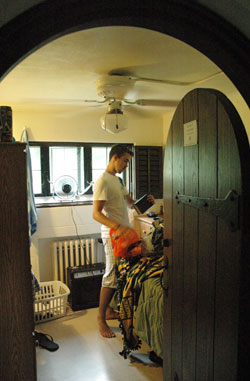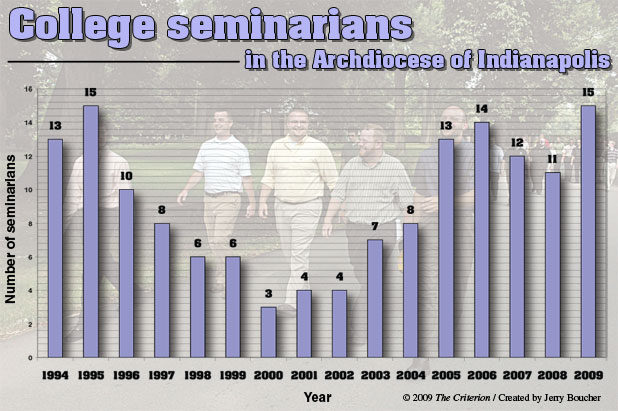Seminary’s presence in archdiocese encourages vocations

Seminarian Kyle Field, a freshman at Bishop Bruté College Seminary in Indianapolis, moves into his room at the seminary on Aug. 13. Field is a member of St. John the Apostle Parish in Bloomington. (Photo by Sean Gallagher)
By Sean Gallagher
A significant factor in the growth in enrollment at Bishop Simon Bruté College Seminary in Indianapolis is the steady increase in the number of college seminarians in the Archdiocese of
Indianapolis over the past decade.
In 2000, there were three college students affiliated with the archdiocese as seminarians. At the start of the 2009-10 academic year, there are 15 seminarians, all enrolled at Bishop Bruté. There have not been this many archdiocesan college seminarians since 1995. (See the graph at the end of this story for more numbers)
The current 15 college seminarians represent more than half of the archdiocese’s 27 seminarians. In addition, seven of the 12 seminarians currently in the final four years of their priestly formation began as college seminarians.
What is behind this considerable growth in the number of college seminarians in the archdiocese?
Father Eric Johnson, archdiocesan vocations director, said the opening of Bishop Bruté in 2004 is a key reason for this growth. (Related story: Full house - Renovations are under way to expand housing at Bishop Bruté College Seminary)
“For the first time in a number of years, we have college-age men that are local, that people can get to know in their presence here,” he said. “You see these ordinary men trying to respond in an extraordinary way to what God is calling them to. That, I think, naturally encourages and inspires others to look at the same thing.”
Seminarian Kyle Field, a freshman at Bishop Bruté and member of St. John the Apostle Parish in Bloomington, met archdiocesan college seminarians as a home-schooled high school student participating in the seminary’s annual youth retreat/camp, Bishop Bruté Days.
“I think exposure to the seminarians themselves helps a lot,” Field said. “You have Bishop Bruté Days and various retreats where the seminarians [are present]. You can see that they’re normal people.”
In the past, archdiocesan college seminarians received formation at the former Saint Meinrad College, which closed in 1998. After that, they were, for the most part, sent to St. John Vianney College Seminary in St. Paul, Minn.
Now they receive their formation in Indianapolis and are present on occasion in parishes both in the city and in other parts of the archdiocese.
This visibility has encouraged other young men to discern a possible call to the priesthood, Father Johnson said.
“There are a lot of reasons to be encouraged about where we’re going in terms of the number of men we have,” he said. “The guys who we have are enthusiastic. They have a real desire to try to live the faith in a concrete fashion. And the more that they’re with others, the more that they inspire [others].”
Father Robert Robeson, Bishop Bruté’s rector, also thinks the opening of the seminary likely has had a “huge impact” on the increase in the number of college seminarians.
He also carefully monitors the degree to which Bishop Bruté seminarians are involved in parishes and schools in the archdiocese.
“Their involvement can play a role in their formation,” Father Robeson said. “But if they’re out all of the time doing [things] at parishes and various ministries, how well are they really going to be able to do the contemplative work that needs to be done at the college level? How well are they going to be able to contribute to the community life that we’re seeking to build here?”
Father Johnson noted the importance of supporting men of various ages to be open to the priesthood.
“I think that [we should] challenge all people—whether they’re in high school, whether they’re in college, whether they’re second career men—to ask those fundamental questions of where is it that God is calling them to, not just in the long term, but in this place at this moment.”
Father Johnson said that, in his visits to parishes across central and southern Indiana, he has seen an increase in the way in which archdiocesan Catholics encourage vocations at the grassroots level.
Field said that was the case for him at St. John the Apostle Parish in Bloomington.
“My parish has always encouraged [vocations], ever since I was really little,” Field said. “If it ever comes up that someone is thinking about it, … everyone is very supportive and wishes [him] the best.
“I know there are several young men at St. John right now who are seriously considering it. And the entire parish supports them.”
Father Robeson said that prayers for vocations on the part of Catholics across the archdiocese have played and will continue to play a crucial role in any future increase in the number of seminarians.
“That’s a huge factor,” Father Robeson said. “You can’t imagine how often I have people come up to me and tell me that they’re praying for Bishop Bruté [seminarians] and praying for vocations to the priesthood. It happens every day.
“Thanks be to God that people are so committed to that.”
(To learn more about archdiocesan seminarians or about discerning a priestly vocation, log on to www.HearGodsCall.com.) †


